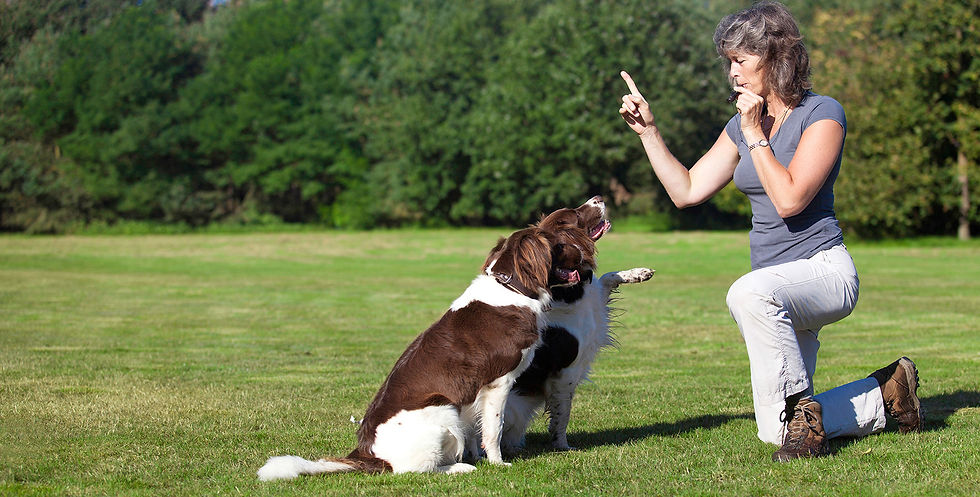Providing Effective Home Training: Tips and Tricks from Professional Dog Trainers
- kristinannieblog
- Aug 13
- 4 min read

Training your dog at home can be both rewarding and challenging. Whether you have a playful puppy or an older dog with some habits to correct, a structured approach to home training ensures lasting results. Professional dog trainers often stress that patience, consistency, and understanding your dog’s unique needs are the foundation of success. Here are expert-backed tips and tricks to help you provide effective home training.
1. Understand Your Dog’s Personality and Needs
Every dog is different. Breed, age, and temperament all play a role in how your dog learns and responds to training.
Puppies may need shorter, more frequent training sessions to hold their attention.
High-energy breeds like Border Collies or Labrador Retrievers might need additional exercise before training to improve focus.
Sensitive dogs respond best to gentle, calm approaches, while confident breeds may thrive with more assertive training styles.
Tip from trainers: Before starting any training program, spend time observing your dog’s behaviour, energy levels, and triggers. This insight helps you choose the right methods for them.
2. Set Clear and Consistent Rules
Dogs thrive on structure. If you allow them on the couch sometimes but scold them other times, confusion will set in.
Decide on house rules before training begins.
Ensure all family members follow the same rules and use the same commands.
Keep training words short and consistent—e.g., “sit,” “stay,” “come”—to avoid mixed signals.
Trainer insight: Consistency speeds up learning because dogs quickly connect the command with the expected behaviour.
3. Use Positive Reinforcement
One of the most powerful training tools is positive reinforcement—rewarding good behaviour instead of punishing bad behaviour.
Rewards can be treats, praise, toys, or extra playtime.
Give the reward immediately after the desired action so your dog links it to the behaviour.
Keep treats small to avoid overfeeding during repeated training.
Pro tip: Over time, gradually reduce treats and replace them with verbal praise or petting to maintain results without creating treat dependency.
4. Keep Training Sessions Short but Frequent
Dogs learn better in short, focused bursts rather than long, exhausting sessions.
Aim for 5–15 minutes, 2–3 times a day.
End on a positive note so your dog looks forward to the next session.
Mix up commands to keep training engaging.
Trainer’s trick: If your dog starts losing focus, stop before frustration builds. This helps keep training fun and productive.
5. Start with Basic Commands
Before tackling advanced tricks, ensure your dog has mastered the basics:
Sit – builds control and focus.
Stay – teaches patience and impulse control.
Come – essential for safety and recall.
Down – promotes calm behaviour.
Leave it – prevents chewing or eating harmful objects.
Once these are consistent, you can move to leash training, hand signals, or agility work.
6. Manage Distractions Gradually
Professional trainers use a distraction ladder—starting with quiet, low-stimulus environments and slowly increasing challenges.
Begin indoors where distractions are minimal.
Move to the backyard, then a quiet park, and eventually busier public spaces.
If your dog gets distracted, step back to an easier level and build up again.
Why this works: It helps your dog build focus and confidence without feeling overwhelmed.
7. Avoid Punishment-Based Methods
Yelling, hitting, or harsh corrections can cause fear and damage trust. Professional trainers emphasize redirecting behaviour instead:
If your dog jumps, turn away and reward calm sitting.
If they bark excessively, teach a “quiet” command instead of scolding.
Trainer perspective: Positive methods build a stronger bond and long-term obedience compared to punishment.
8. Socialisation is Part of Training
Training isn’t just about commands—it’s also about teaching your dog how to behave around people, animals, and different environments.
Introduce new experiences gradually.
Reward calm and friendly behaviour during socialisation.
Avoid overwhelming your dog with too much at once.
Bonus tip: Puppies have a “critical socialisation window” between 3–14 weeks, but older dogs can still learn with patience.
9. Use the Right Training Tools
Choosing the right tools can make home training easier:
Clickers for clicker training
Front-clip harnesses for better leash control
Long lines for practicing recall in open spaces
Interactive toys for mental stimulation
Avoid choke chains or prong collars unless guided by an experienced trainer, as misuse can cause harm.
10. Be Patient and Persistent
Even professional trainers know that setbacks happen. Progress isn’t always linear, and dogs may regress under stress, illness, or change.
Celebrate small wins.
Stay calm and avoid frustration.
Remember that training is a lifelong process, not a one-time task.
11. When to Seek Professional Help
If your dog shows signs of aggression, anxiety, or persistent disobedience, certified dog trainers or behaviourist can provide tailored strategies.
They can observe your dog’s behaviour and pinpoint root causes.
Group classes can also improve social skills while reinforcing obedience.
Final Thoughts
Home dog training is an opportunity to strengthen your bond and create a well-mannered, confident companion. By applying proven techniques from professional trainers—like consistency, positive reinforcement, and gradual challenges—you can achieve lasting results. Remember: training should be a fun, rewarding experience for both you and your dog.
With patience, clear communication, and the right approach, your home can become the perfect training ground for your furry friend.




Comments